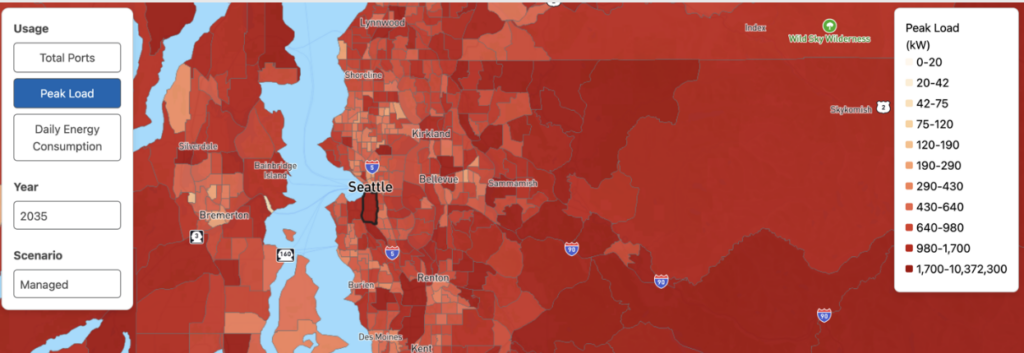Sign up for daily news updates from CleanTechnica on email. Or follow us on Google News!
RMI’s GridUp tool helped Washington State develop leading strategies for transportation electrification.
Across the country, electrifying transportation can help states meet climate targets, but policymakers must ensure it happens smoothly. In Washington State, policy leaders are using cutting edge tools and analysis to prepare for an electric vehicle (EV) future. The Washington State Transportation Electrification Strategy (TES), a first-of-its-kind policy effort, is designed to ensure that Washington develops an electrified transportation system which is as efficient, equitable, and effective as possible.
Development of the TES encompassed several key components, including intensive stakeholder engagement, consumer outreach and research, rigorous quantitative analysis, and ultimately support for the state in developing policy recommendations. While the pace and comprehensiveness of this strategy development overall was novel for a statewide planning effort of this scale, the analytical approach taken to support the TES was particularly innovative.
The analysis that informed the TES, led by RMI, focused on assessing different potential EV adoption pathways in the state, paired with cutting-edge, hyper-local modeling of when and where these vehicles will need to charge. This data driven analysis was essential for understanding how the EV market might grow on its current trajectory, whether that trajectory will reach Washington’s 2030 goal of 100 percent zero-emissions vehicle sales for passenger autos, how the growth of the EV market will be impacted by specific policy mechanisms, and where the state and its utilities should focus to prepare the electric grid to support these vehicles’ charging needs.
Assessing EV Adoption Pathways
The first part of the analysis enabled the RMI team to test different market and economic factors, policy supports, and consumer preferences, and analyze the impact each would have on EV adoption. Exploring potential EV adoption across different types of vehicles — for example, pickup trucks and SUVs, sedans, and delivery vans — in different parts of the state provided a detailed view of the pace and geographic distribution of EV growth in the Evergreen state over time, as well as how different scenarios of EV growth would impact the state’s progress on emissions reductions goals.
Meeting Washington’s Climate Goals
Washington State has mandated that 100 percent of all passenger vehicle sales be zero-emissions by the year 2030. At the same time, the state has a goal of reducing economy-wide greenhouse gas (GHG) emissions to 50 million metric tons (MMT) per year, 45 percent below 1990 levels. To meet the state’s 2030 limit, the GHG emissions from on-road vehicle likely need to be less than 10 MMT CO2e annually. The TES analysis found that to achieve this level of GHG reduction, the state must not only reach its 2030 EV goal, which would bring on-road emissions to 13.6 MMT by 2030, but also double down on additional transportation electrification policies.
These key takeaways highlighted critical gaps that could prevent Washington from reaching its goals, and illustrated key solutions needed to help bridge these gaps, including the need to make electric vehicles more affordable. The TES included policy recommendations to this end including launching a targeted, up-front, point-of-sale EV rebate program, and creating a state-supported low-cost leasing program with an EV equity objective. Additionally, to support a smooth adoption of EV mandates, it is essential that the state implement complementary policies, including those focused on consumer education and infrastructure development.
Exploring the Implications of EV Adoption
The second part of the analysis, using an early version of our just-launched GridUp EV load forecasting tool, allowed us to explore in detail the implications of this EV adoption, from both an electric grid and local planning perspective. One of GridUp’s key innovations is using hyper-local travel data from existing vehicles to paint a detailed picture of how people are likely to drive their EVs as more and more of the cars and trucks on our roads ditch the gas pump in favor of the electrical outlet.
This two-stage modeling approach is a one-two punch for understanding both how quickly Washington might expect EVs to show up on roads (and what policies might help to speed up that transition), and what those vehicles will mean for the electric grid. There is huge opportunity for state policymakers to work with drivers and fleets to direct their charging to locations on the grid that have extra room (“excess capacity”) and also to times when it’s easier (and cheaper) to provide electricity for charging. However, the state will still need to build out its electric grid to accommodate EVs and the many other end-uses that are becoming electrified (e.g., hyper-efficient heat pumps for water and space heating, or clothes drying). It’s essential that those investments are made strategically, both so that the grid doesn’t become a bottleneck to electrification, and so that we ensure the transition to cleaner, more efficient cars and buildings can be kept affordable.
GridUp — Washington and Beyond
GridUp provides key insights as to where and when that investment will be needed to support the electrification of our transportation. After having successfully deployed these analytical methods in Washington State, we’re excited to be rolling them out nationwide, aiming to support state and local policymakers, utility planners, regulators, community-based organizations, and other stakeholders to better understand what the transition to EVs may mean in their local area. As was demonstrated in Washington, this data can play a critical role in developing important energy policies. GridUp is public and available to support decision makers in planning the grid infrastructure needed to enable transportation electrification nationwide.
© 2023 Rocky Mountain Institute. Published with permission. Courtesy of RMI. By Ben Shapiro
Have a tip for CleanTechnica? Want to advertise? Want to suggest a guest for our CleanTech Talk podcast? Contact us here.
Latest CleanTechnica.TV Videos
CleanTechnica uses affiliate links. See our policy here.
CleanTechnica’s Comment Policy






